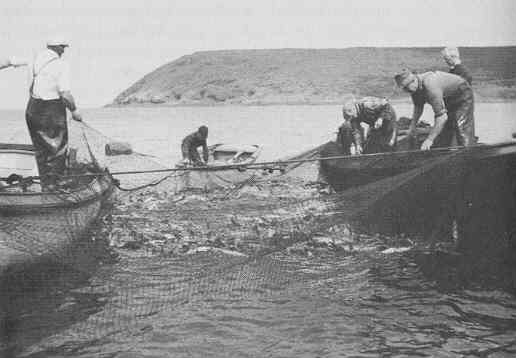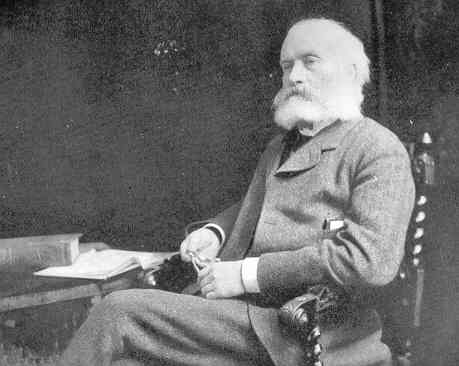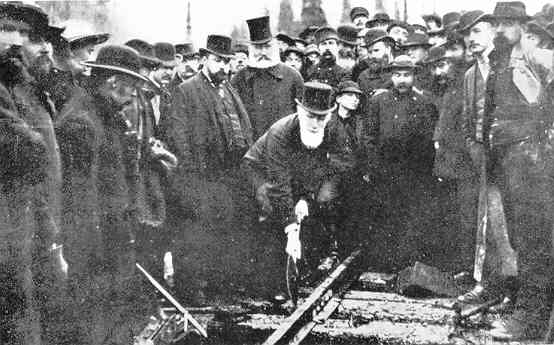Newfoundland's early settlement and transportation
The cod fishery, Sandford Fleming and railways, coastal ferries.
John Cabot, a Venetian reporting to England, stumbled
on rich fishing grounds in 1497 - then everyone found out about Newfoundland
and the Grand Banks.
A Portuguese explorer landed on the Avalon Peninsula,
claimed it for the King of Portugal, and named St. John's Harbour
while he was at it. This was in 1501. St. John's Harbour was a handy
place to hide out during a storm or to make repairs.
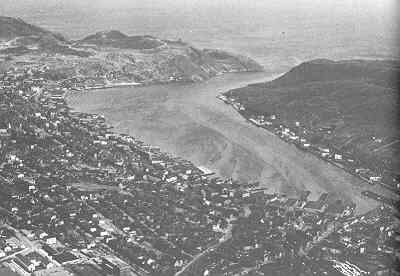
You really have to experience the harbour firsthand. It is
about 2 kilometres in length. As you walk along the shore closest to the
bottom of this old aerial view, Signal Hill looms larger and larger.
Signal Hill is on the far side of the harbour entrance. At the top of
Signal Hill is the Cabot Tower - three stories tall and completed in 1900.
It's the little black square on top of the hill with the ocean behind.
Looking in the other direction - from Signal Hill into The Narrows,
and on to the end of the harbour - gives you a better idea of the
size of this gigantic rock formation. Much of the harbour is hidden
behind the outcropping at the right :
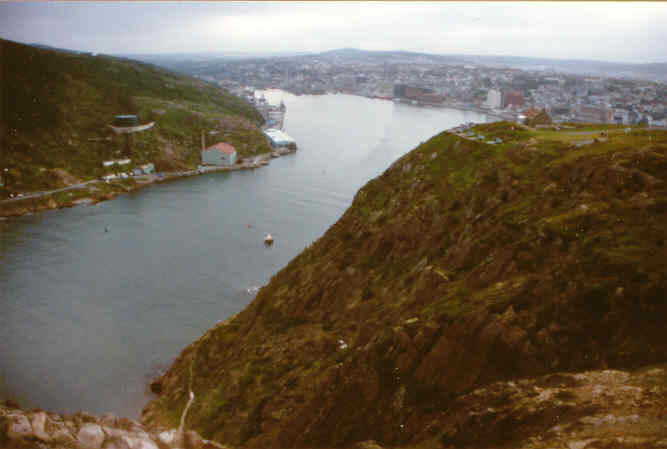
The most valuable catch during the 1500s was cod. The most
important species, Atlantic Cod, likes capelin and herring (it's
not mutual). The cod spawn during cool months - for example they spawn
on the Grand Banks between April and June. Spawning times vary widely
during the year depending on local water conditions. Baby cod eat plankton
and little creatures they find on the bottom. Except for coming to the
surface while chasing small fish, cod tend to stay near the ocean floor.
The English were late to the fishing party in Newfoundland
- only really getting interested when closer European fish stocks
were dominated by other countries. By the time they arrived
the 1570s : Portugal, Spain, France and Basque fisherman were well
established in Terra Nova with fishing and whaling.
These southern Europeans had lots of access to salt. In
their sunny dry climates, salt producers would shepherd seawater through
an interconnected succession of shallow ponds. The hot sun changed the
seawater to stronger and stronger brine, and finally to crystalline salt.
Access to salt allowed them to use "green fishery
" techniques. Fresh prepared cod were salted away in their ships'
holds in a two stage process. The fishing ships travelled about one
month to the Grand Banks, stayed at sea to fish there during the April
to October fishing season, and spent another month getting home.
They could go ashore at St. John's or at other locations,
but they didn't need to. It was better to fill the hold with
salted fish as soon as possible and get home.
Without as much access to salt, the English needed to go
ashore to dry their fish - a "dry fishery" process. Having
predictable access to land was more important for them than for the
French, Spanish, Portuguese and Basques.
Sir Humphrey Gilbert blew into St. John's Harbour with the
hesitant support of Queen Elizabeth I in 1583 and told everyone else
to take their salt and stow it ... England was now in charge! I guess
he could do that kind of thing - his half-brother was Wally Raleigh the
Smoker.
Newfoundland cod was soon bringing in a lot of money
to England.
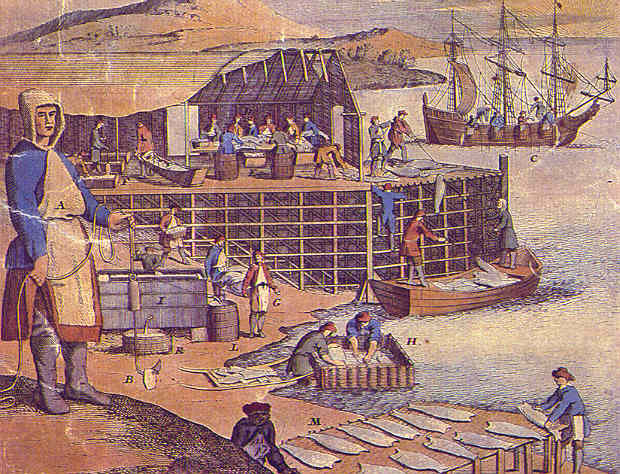
When he is done posing, the dude (A) will take his leather
apron, baited weighted hook (B), and get on the sailing ship at (C).
Green Fishery made fun and easy
Once on sailing ship (C), he will stand in one of the barrels
fastened to the ship's side, with his leather apron hanging outside
to keep him dry. As he pulls in fish all day, he will send them up
over his shoulder for gutting, heading and stowage with some salt to
let the juices flow out (yum). A couple of days later they will repack
everything with some more salt. As soon as the hold is full, it's back
to Europe to sell ... while the English are still doing the rest of the
alphabet.
Dry Fishery made fun and easy
Every night, take the fish to the dock and get them gutted,
headed and split. Brush them with brine and let them set a spell.
A couple of days later, wash them and lay them out on "wooden split-cod
drying tables" - called flakes for brevity. Keep them
as sunny, airy and DRY as possible and the dried cod will be ready in
a few weeks ... but you have to keep flipping them over. Keep them dry
on the way back to England too !
Whether you like to salt them away, or flake them out,
Atlantic Cod is goood eatin' !
Fishing structures and settlement
The winter winds, heavy wet snow and pounding drift ice
took a toll on the dry fishery structures. Every year they had to
be rebuilt.
The "West Country Merchants" of England liked all the dried
cod coming in, and fishing supplies going out, only through their
hands. They had influence with the English government and used the law
and brute force for decades to ensure that no one overwintered in Newfoundland.
If people settled in Newfoundland, influence on the colony might pass to
local merchants and local government.
By English law, the first English ship's captain arriving at St. John's
in the spring got to be "Fishing Admiral" for the season. Without university
prerequisites in public administration or political science, Fishing Admirals
administered "justice" on behalf of the government and were often very
brutal.
Speaking of brutal ... St. John's and its environs kept
changing hands between the English and French, French and English
... (Newfoundland? ... sounds like Canadian history!).
Iberville and Jeffrey Amherst's little nephew William were a couple
of those involved during this long and tedious bit of history. I would
do a whole page on this alone, but there's no spellcheck
for Utrek ... as in Treaty of ...
Survival in pioneer Newfoundland is hard enough ... can't
we all just get along?
Anyway ... back around 1700, some inhabitants kept their heads
down and discreetly began permanent settlement away from all the action
around St. John's and the drift-ice-free French fort at "Plaisance"
(today's Placentia). To over-simplify, these first settlers came mainly
from the seasonal population which was made up of garrison soldiers,
fishing workers and "private sector support services" like carpenters
and use your imagination. Life wasn't easy for these first permanent settlers.
Outport Life
... The dispersion of permanent settlement beyond St. John's
continues, and the need for better transportation develops ...
If fishermen didn't want to work for "The Man
" aboard sailing ships on the Grand Banks - or onshore with the dry
fishery work ... they might settle somewhere down the coast in what
came to be called an "outport" - a little isolated settlement which was
often accessible only by sea.
Below is the "pseudo-outport" of Quidi Vidi Harbour - minutes
from Signal Hill and downtown St. John's (you can see the hill at the right
on the aerial view). The camera is looking toward the harbour entrance
and the ocean. There were many of these peaceful little areas all along
the coast of Newfoundland where people began to settle. You can get
the "outport idea" from this place ...

- Probably in the 1950s, the fishermen below are bringing
in a "cod trap".
- A cod school comes inshore, perhaps looking for capelin,
and swims into a net obstruction shaped like a wall.
- The cod react by swimming along the wall ... which leads
into a box-shaped net (having sides and a bottom). The "box" is held
in its shape by ropes and anchors.
- Before the cod can find and exit through the small entrance,
fishermen activate the trap by lifting the net enclosure out of the
water.
The inshore cod trap and other low technology processes
such as manually set lines of baited hooks stood the test of time. Used
in a labour-intensive small-scale way, they were ecologically reasonable
and sustainable.
Gee, it must have been great ... just living off the
land and in harmony with nature like that !
... Often with big families, outport fishermen often ended up working
very hard for "The Man" anyway - not themselves.
For perhaps 200 years, a "merchant credit" system operated.
When cod prices were poor, or the inshore cod schools were not plentiful,
fishermen got into debt. A go-between merchant would get access to a
St. John's trading company's fishing supplies and financing ...
Probably in a better boat than any of the local fisherman
owned, the merchant would travel to a series of outports, providing
credit in the form of fishing equipment at the beginning of the season.
In return for credit, a fisherman would agree to hand over his catch
to apply to the debt. Over the years, the debt never seemed to go away
...
Here is a conclusion about the merchant credit system, written
in the late 1960s :
"His complete dependence on the local merchant for
credit,
coupled with his old-fashioned catching and curing methods,
condemned [the fisherman] to a lifetime of unrewarding labour."
Sandford Fleming stirs things up
Sir Sandford Fleming : The foremost railway surveyor
and construction engineer in Canadian history.
- 1827 born a crusty old Scottish baby (with a beard) at Kirkcaldy.
- 1836 the Canadian railway age begins.
- As soon as he is tall enough to operate a dumpy level, Fleming works
for various railway companies in Canada.
- 1861-1865 The American Civil War demonstrates the strategic
value of railways in war.
- 1863 Government appoints Fleming to survey a railway to join
Quebec City, Saint John and Halifax (The Intercolonial).
- 1863 Fleming presents a petition to the British authorities
from the Red River settlers requesting a railway to connect them with
eastern British North America.
- 1868 Fleming starts nosing around Newfoundland regarding a railway
... with Canada's encouragement.
- 1871 Fleming appointed engineer of the proposed railway to run
from Montreal to the Pacific [later the CPR]
- 1872 Fleming surveys numerous Pacific railway routes through
the west, giving the Reverend George M. Grant the opportunity to write the
book "Ocean to Ocean" about the journey.
- 1873 Prince Edward Island joins Confederation, partly to have
Canada bail out the railway debt, and also to pay for the operation of
its expensive, overbuilt railway system ... It was really bad
!
- 1874 Newfoundland premier Carter suggests that Newfoundland
be surveyed for a railway.
- 1874 Many Newfoundlanders freak out. Railway may
bankrupt the island! The Canadian government may be plotting to ruin Newfoundland
financially so it must join Confederation ... just like PEI !!
- 1875 Fleming organizes and oversees Newfoundland railway survey
but his primary focus is still the Intercolonial.
- Problems with the Newfoundland railway survey :
- Surveyed route is direct and ignores a number of coastal communities.
- Proposed terminus is St. George's Bay on the "French Shore" - i.e.
where only the French have fishing rights by treaty but they may not settle.
Why put a terminus there?
- The expense. Standard gauge will cost about $8.5 million.
- Politics!
- The British Colonial Office looks at the list or problems and refuses
construction guarantees ... In other words, if the railway
sells bonds to British banks and other investors to raise money for construction
... and if the railway goes bankrupt ... the project was not
"approved" by Britain ... and investors have lost their money
.
- Fleming's idea of a trans-Newfoundland railway is dead.
Fleming was probably looking at a bigger picture - rather than Newfoundland's
needs ...
The War of 1812 was fresh in Canadian political memory. Fleming believed
that he could do a lot to unite the scattered British North American territories
with that greatest of all 19th century technologies ... the railway.
Fleming's "big picture concept"...
He seemed to think that a Newfoundland Railway could provide a
fast land bridge connecting British steam ships arriving at
St. John's with the new Intercolonial Railway (via ferry) ... and so on
... all the way out to the Pacific Ocean.
The buzz terms for transcontinental
railways across British North America back then were 'Steel of Empire' or 'Imperial Highway'.
CPR Last Spike - November 7, 1885 - Craigellachie,
B.C.
Spike maul swung by CPR Syndicate member Donald Smith.
Immediately left of him with dark beard: W.C. Van Horne, General
Manager.
Between them, tall with white beard, Sandford Fleming.
(All 3 men died 1914-1915)
Political Reality
- In 1869 Newfoundland had already said "no" to Canadian Confederation.
- In the late 1800s Newfoundland had a population of less than 200,000
- much of it scattered along the coast.
- Many of the 'Big Fish' of tiny Newfoundland didn't want their influence
undermined by the outsiders a railway would bring, and they certainly
didn't want to pay more taxes to build a railway.
So how are you ever going to get a railway built
in Newfoundland?
Final Point - classic marine transportation patterns in Newfoundland
- After the CNR had upgraded and re-equipped the
Newfoundland Railway in the 1950s ...
- After roads and automobiles had become popular
in the rest of Canada ...
The large map below helped me better understand the settlement patterns,
and historic marine transportation needs, along Newfoundland's rocky coast.
This is a Canadian National Railways modern map from the early 1960s.
It shows the railway lines which the CNR inherited and operated after Newfoundland
joined Confederation in 1949.
More significantly, it shows the coastal steamship routes
the CNR was committed to operate - the dotted lines all around
the island. Some of routes were seasonal, closed "at the end of navigation"
in the local area.
CNR used the following vessels in 1957:
S.S. Baccalieu ; S.S. Bar Haven ; M.V. Bonavista ; M.V. Burin ; M.V.
Nonia ;
M.V. Clarenville ; S.S. Northern Ranger ; S.S. Springdale ; S.S. Kyle
The direct mainland service between Port-aux-Basques and North
Sydney was provided by:
S.S. Cabot Strait ; S.S. Burgeo ; M. V. William Carson.
A trans-Newfoundland railway did get built ...
only a dozen years after the CPR was completed across Canada.
And there were a few CPR connections with the project too ...
Back to sitemap





